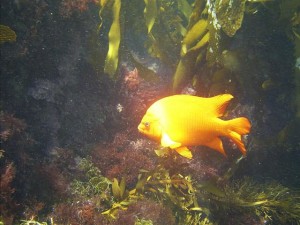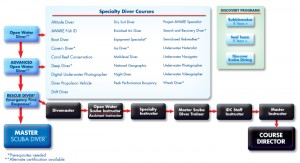Specialty Diver Courses
What are PADI Specialty Diver Courses? When PADI developed their continuing education model, they realized that divers have a lot of varied interests. For me, it’s underwater imaging (underwater photography and underwater videography) and dive safety. To accommodate those interests, they started developing courses that go into more depth about a certain topic. If you’re familiar with Adventures in Diving Program or Advanced Open Water Diver, you’ve experienced a sample of these specialty areas.
PADI has a multitude of Specialty Diver courses that can help you explore your interests in diving and the list continues to grow. Here’s a short sample:
- Altitude Diver
- Boat Diver
- Deep Diver
- Diver Propulsion Vehicle
- Dry Suit Diver
- Emergency Oxygen Provider
- Enriched Air Diver
- Equipment Specialist
- Fish Identification (AWARE FishID)
- Digital Underwater Photography
- Multilevel/Computer Diver
- Underwater Naturalist
- Underwater Navigator
- Project AWARE Specialty
- Project AWARE Coral Reef Conservation
- Search & Recovery Diver
- Night Diver
- Underwater Photographer
- Underwater Videographer
- Wreck Diver
In some cases, instructors can author (or be trained ) and teach PADI Distinctive Specialty courses. For example, here are some PADI Distinctive Specialties I can teach:
- AWARE Shark Conservation
- Neurological Assessment
- AED for Scuba
- First Aid for Hazardous Marine Life Injuries
- Oxygen First Aid for Scuba
The last four correlate to the DAN Diving First Aid courses I teach. Take the DAN course and get the PADI Distinctive Specialty at the same time!
Specialties are typically designed to give you, the diver, a safe and structured way to explore the specialty area. After the initial dive or two, I, as the instructor, usually back off and act as a resource rather than just tell you what to do. That way you develop the comfort to continue exploring that specialty area of diving. For example, the PADI Altitude Diver Specialty has two dives. The first dive involves a good amount of pre-dive planning and we compare depth gauges during the dive. The depth gauge comparison helps you understand why we dive conservatively. On the second dive, you plan the dive and I’m there to help and answer questions. It can vary between specialties, of course.
Specialties are not designed to make you an expert, though. For example, the PADI Equipment Specialist course isn’t to train you to break down and rebuild regulators. [That requires training from the manufacturer.] We do look at how regulators are built and how they work. We practice basic field repairs such as repairing a wetsuit or replacing an o-ring. The PADI Equipment Specialist course is an excellent course for all divers, as it will help you with all of your equipment purchases, long-term equipment maintenance and basic field repairs.
PADI Specialties do have an important relation with the Adventure Dives in Adventures in Diving (Adventure Diver & Advanced Open Water Diver). The first dive in a given specialty is the same as the correlating Adventure Dive. That means that if you’ve completed any Adventure Dives, they can count towards the correlating specialty. If you’ve completed the Specialty, the first dive of that Specialty can count towards your Adventure Diver or Advanced Open Water certification.
Specialty Diver courses also count towards your PADI Master Scuba Diver rating. Jump over to the Master Scuba Diver page to learn more.
Questions about PADI Specialty Diver courses? Contact me!


